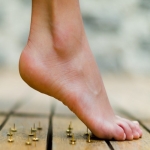Do you have a constant, stabbing pain in the foot or heel that seems unbearable? You might have plantar fasciitis.

What is Plantar Fasciitis, its causes, and symptoms?
Plantar fasciitis is the most common cause of heel and foot pain. Though the exact cause of plantar fasciitis is unclear, it usually occurs when the tissues under the foot that form the arch (plantar fascia) are over-stretched or over-used and become irritated or inflamed. Plantar fasciitis typically affects runners, people who are overweight, or those who wear shoes with inadequate support.
Symptoms
Symptoms include a stabbing pain in the bottom of the foot near the heel. The pain is usually worse after exercise (not during) or within the first few steps after awakening in the morning. Pain can also be triggered by long periods of standing or rising from sitting.
What are the risk factors for Plantar Fasciitis?

Plantar fasciitis can occur without obvious cause, though there are factors that increase your risk for development:
- Age. It is most common between the ages of 40 and 60.
- Certain types of exercise. Activities such as long distance running, ballet or aerobic dancing, and ballistic jumping can place increased stress on the heel and attached tissues.
- Foot mechanics. Being flat footed, having a high arch, or an abnormal walking pattern affects the way weight is distributed while standing which can place added stress on the plantar fascia.
- Obesity. Excess pounds add extra stress to your feet.
- Occupations that keep you on your feet. Factory workers, teachers, or those who spend long hours walking or standing on hard surfaces (such as concrete) can damage the plantar fascia.
Are there complications with Plantar Fasciitis?
Ignoring your symptoms may result in chronic pain that hinders daily and recreational activity. It can also affect the way you walk, resulting in pain in the foot, knee, hip, or back pain.
What are the treatment(s) available for Plantar Fasciitis?

There are several conservative treatments available for plantar fasciitis:
- Anti-inflammatory regimens. Medications such as Advil, Motrin, and Naproxen can help ease the pain and inflammation associated with plantar fasciitis.
- Therapies:
- Physical Therapy: A therapist can instruct you in a series of exercises to stretch and strengthen the plantar fascia and Achilles tendon of the foot. These stretches also help surrounding areas such as the lower leg muscles that help stabilize your ankle and heel.
- Night splints. Your therapist or doctor might recommend a splint that stretches the calf and arch of the foot while you sleep. This helps to stabilize the plantar fascia and Achilles tendon in a lengthened position overnight to facilitate stretching.
- Orthotics. You doctor might also prescribe off-the-shelf or custom-fitted arch supports to help support and distribute pressure more evenly to your feet.
If no relief is sought with conservative treatments, your doctor might recommend:
- Injections. Steroid injections into the affected areas can provide temporary pain relief, though multiple steroid injections are not recommended as they can weaken the plantar fascia over time, resulting in a rupture of the tissue. A second option for injection is protein rich plasma performed under ultrasound guidance. These injections have recently gained popularity and do not pose the same risk as steroids.
- Surgery. While few people need surgery for relief, it is an option only when pain is severe and all other treatments have failed. During this procedure, your surgeon will detach the plantar fascia from the heel bone. Side effects can include weakening of the arch in the foot.

There are also simple self-management techniques that can help you avoid exacerbated pain or worsening of your plantar fasciitis:
- Maintain a healthy weight.
- Choose supportive shoes. Avoid high heels and do not go barefoot, especially on hard surfaces.
- Don’t wear worn- out athletic shoes. Replace your athletic shoes before they stop supporting and cushioning your feet. If you are a runner, replace your shoes every 400-500 miles.
- Change your sport. Try a low-impact sport, such as swimming or cycling.
- Apply ice to reduce pain and inflammation and stretch often. Simple home exercises can stretch and strengthen the tissues and muscles in the foot and ankle, providing ample support to the plantar fascia.
If you believe to have unbearable, sharp foot and heel pain, schedule an appointment with our foot and ankle specialist, Dr. John Bleazard, for further evaluation and treatment.
By: Megan Hefner, MS, CRC
Sources:
http://www.sportsinjuryclinic.net/sport-injuries/foot-heel-pain/plantar-fasciitis

